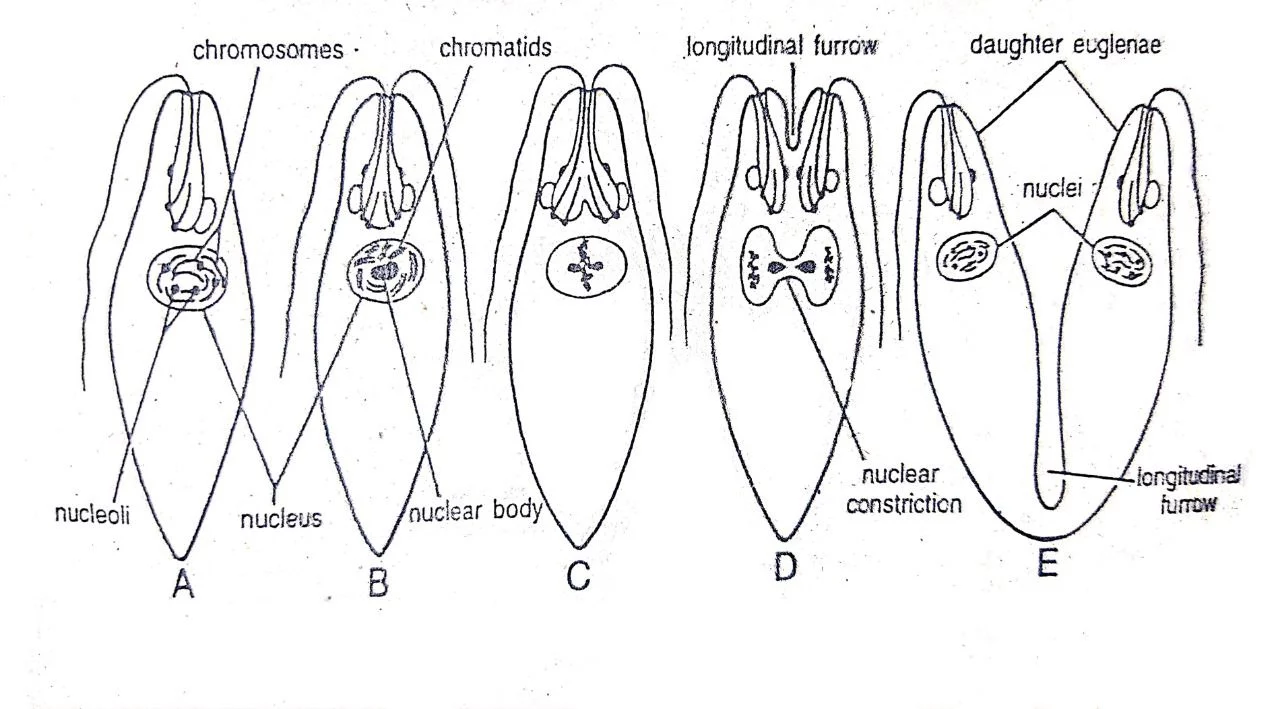In this article, we will learn about the reproduction of Euglena. The method of reproduction of Euglena is asexual. Asexual reproduction occurs through binary fission, where the cell divides into two daughter cells. They can also reproduce by forming cysts that can survive in harsh environmental conditions and when conditions improve, the cysts will hatch. The cysts are formed by the process of encystment which is triggered by changes in environmental conditions.
What is Reproduction?
Reproduction is the biological process by which organisms create descendants. This can be achieved either sexually or asexually. In sexual reproduction, two individuals, typically of different sexes, produce offspring by combining their genetic material through the fusion of gametes. Asexual reproduction, on the other hand, involves the production of offspring without the fusion of gametes. This can occur through processes such as budding, fragmentation, or self-fertilization. The resulting offspring are genetically identical to the parent organism. The goal of reproduction is to pass on genetic information to the next generation, ensuring the survival of a species.
Reproduction of Euglena
- No sexual reproduction occurs.
- It only exhibits asexual reproduction such as binary fission and multiple fission.
- Reproduction by binary fission involves an organism merely splitting into two identical halves.
1. Binary Fission

- The reproduction process occurs under favorable conditions of water, temperature, and food availability.
- Euglena divides by a simple longitudinal binary fission. Transverse binary fission is unknown in them.
- In this longitudinal division, the parental Euglena divides into two individuals.
- The new individuals are plane mirror images of each other.
- First, the nucleus divides into two by mitosis. Then the cytoplasm also divides.
- There is an unusual feature observed in the nuclear division which is the persistence of the nuclear membrane.
- In prophase, all the nucleoli fuse into a single nucleolar body and each chromosome divides longitudinally into two daughter chromosomes or chromatids.
- In the metaphase stage, the paired chromatids lie in a longitudinal plane. Microtubules are present in the nucleus but do not form a spindle.
- In anaphase, the paired chromatids separate and move toward their respective poles. The nuclear membrane begins to constrict longitudinally.
- In telophase, constriction in the nuclear membrane deepens and finally separates the nucleus into two daughter nuclei.
- Then the division of cytoplasm occurs. A longitudinal furrow appears in the cytoplasm from the anterior end, which deepens and finally divides the Euglena into two.
2. Multiple Fission and Palmella Stage
- During unfavorable environmental conditions, Euglena undergoes multiple fission in an encysted condition.
- In that period, Euglena can not move and the flagellum is thrown off.
- It becomes rounded and embedded in an extensive, thick, and mucilaginous coat or cyst.
- This coat or cyst is secreted by the muciferous bodies.
- Encystment is usually followed by repeated longitudinal binary fissions with the formation of several daughter individuals(16-32), embedded in a mucilaginous mass.
- The daughter individuals secrete their own mucilaginous coat inside the mucilaginous mass.
- Later these daughter individuals acquire flagella and escape to grow adults.
What is Encystment Found in Euglena?
Encystment is a cyst wall, secreted in the form of a thick, spherical, gelatinous covering composed of a special carbohydrate to tide over unfavorable environmental conditions.
- It is a protective coat.
- It takes place to save Euglena in unfavorable conditions such as lack of food and oxygen, drought, excessive heat, etc.
- It is thick, spherical, yellowish brown, and gelatinous covering.
- It is composed of a special carbohydrate.
- When the conditions become favorable, the animal becomes active.
- The individual may undergo several divisions inside the cyst.
———-THE END———
See more:
- Encystment of Euglena
- Locomotion (Movement) and Nutrition of Euglena | Diagram
- Structure of Euglena with Labeled Diagram
- General Characters of All Phylum of The Invertebrates.
Reference:
- “Modern Textbook of Zoology Invertebrates” written by R. L. Kotpal.
- Euglena | Definition, Diagram
- Euglena Reproduction wiki

Md Ekram Hossain Bhuiyan is a passionate student currently pursuing his studies at Jagannath University in Dhaka. He is a zoology major and his love for animals, nature, and wildlife is evident in his academic pursuits. Ekram is a curious and adventurous individual who always seeks to learn more about the world around him. His passion for animals began at a young age, and he has since dedicated himself to studying the behavior, anatomy, and habitats of various species.
He finds peace in being surrounded by the beauty of nature and observing the creatures that call it home. He believes that it is important to protect and preserve the natural world for future generations.
As a student of zoology, Ekram is dedicated to expanding his knowledge of the subject. He is a hardworking individual who strives for excellence in his studies and is always eager to take on new challenges. Ekram is a driven and compassionate individual who is dedicated to his studies and his passion for animals, nature, and wildlife.